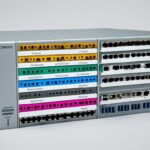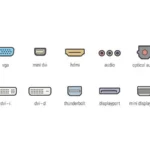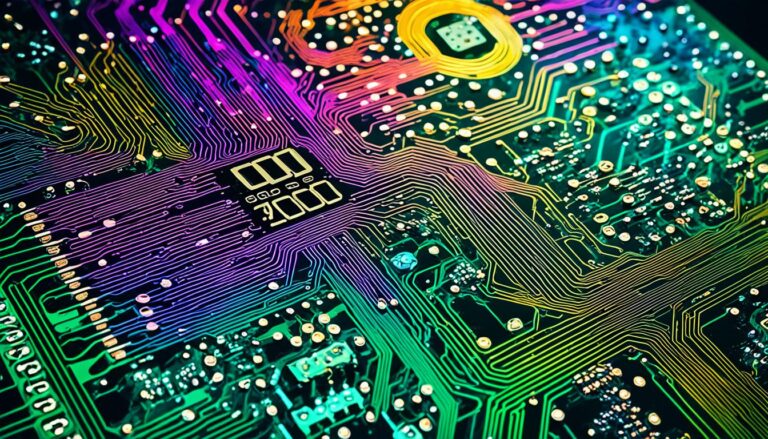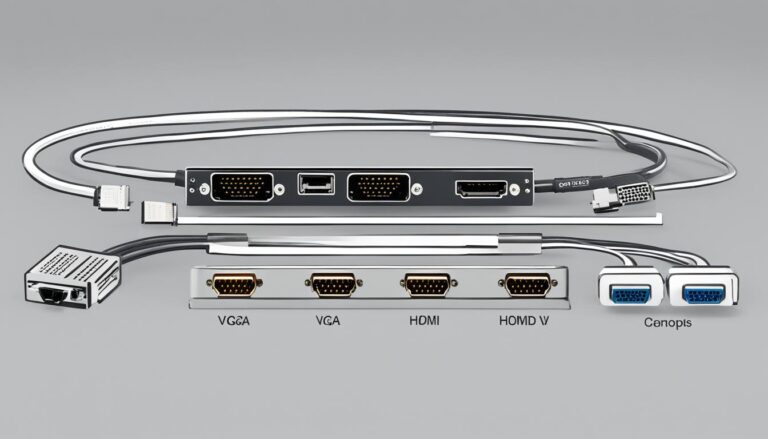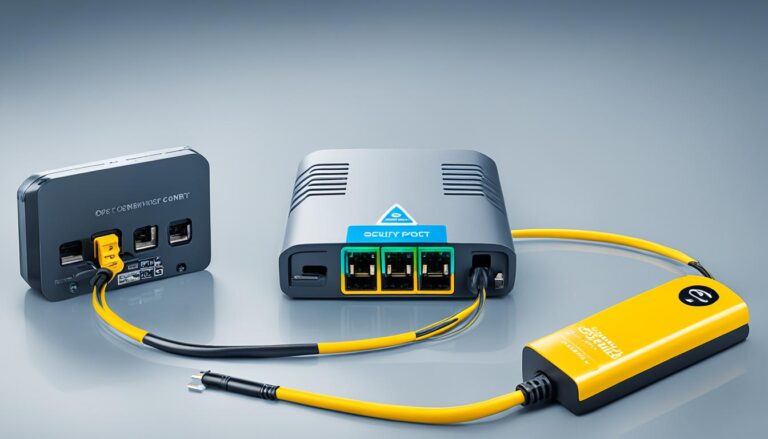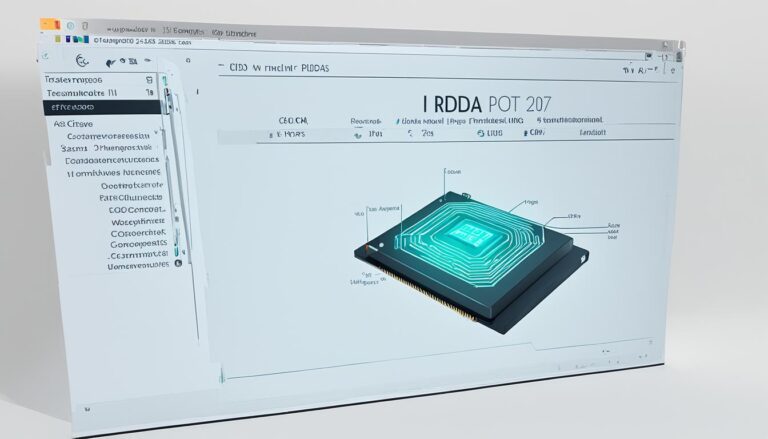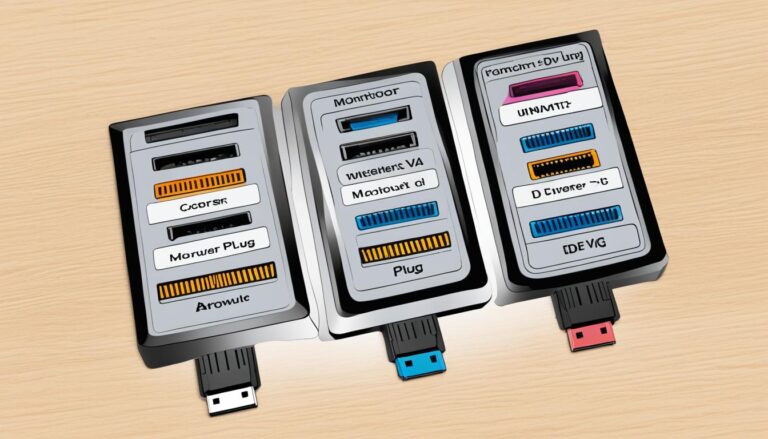Choosing the right connections for your monitor is key. It involves knowing about different display ports. You’ll come across several types, such as VGA, DVI, DisplayPort, HDMI, and USB Type-C.
VGA stands for Video Graphics Array. It’s an older tech mostly seen in older video gear. However, it’s gradually giving way to modern connection methods. DVI, meaning Digital Visual Interface, offers superior image quality. It remains popular in desktops and liquid crystal display monitors.
HDMI, or High Definition Multimedia Interface, represents a newer generation. It handles both video and audio, making it great for home theaters. DisplayPort is another connector you’ll find on computers. It offers capabilities similar to HDMI. Lastly, USB Type-C is truly versatile. It can carry video, audio, data, and power. This makes it suited for a broad array of devices.
VGA – An Old-School Technology
VGA, short for Video Graphics Array, is a technology that’s been around for a while. IBM launched VGA in 1987. It was all the rage for video cards, monitors, and laptops back in the day. Unlike newer technology, VGA only transmits video through analog signals, not audio. Now, as we have better options for connecting displays, VGA is becoming rare. Digital ports providing improved video and sound quality are taking over.
The Legacy of VGA
VGA has left its mark on display technology. After its creation by IBM in 1987, VGA set the standard. It connected computers to all sorts of screens. People loved it for its simplicity and dependability for showing images and videos.
Even though it’s old, VGA had its benefits. It used analog signals. This allowed it to work well with many different devices and screen resolutions. You’d find a VGA port on many devices, ensuring a solid link for numerous gadgets.
“VGA’s analog signals made it compatible with various devices, ensuring a seamless connection between computers and displays,” says Sarah Roberts, a technology expert.
The Rise of Digital Connections
But technology moved forward, and soon VGA wasn’t enough. We wanted better pictures and sound. So, digital connections like HDMI and DisplayPort stepped in. They offer much better video and audio quality.
Since VGA relied on analog, it couldn’t keep up in delivering crisp, high-definition visuals. HDMI and DisplayPort opened up a new world of quality. They showed just how much VGA lagged behind.
“The transition from VGA to digital connections like HDMI and DisplayPort has revolutionized the way we consume visual content,” explains Roberts. “Digital connections allow for higher resolutions, improved color accuracy, and the ability to transmit audio and video signals through a single cable.”
So, we see fewer and fewer VGA ports on new gadgets now. Laptops and TVs today mostly have digital ports. VGA hangs on in some older equipment and niche uses. However, it’s clear that digital connections are the future. They bring us better images and sound.
DVI – Better Picture Quality
DVI, or Digital Visual Interface, gives a clearer picture than VGA. VGA sends analog signals, but DVI uses digital. This means videos look better and clearer.
Though DVI is getting older, it remains useful. Newer options like HDMI, DisplayPort, and USB Type-C are more usual now. But DVI is still good for older gadgets. Many desktops and LCD screens have DVI, which helps with compatibility.
Advantages of DVI
- Digital Signals: DVI uses digital, not analog, signals. This improves video quality and clarity.
- Compatibility: Many desktops and LCD monitors support DVI. It’s easy for people to connect their devices.
DVI may not be new, but it’s still a solid choice. It’s great for quality video and works with many devices that support it.
Knowing about different monitor ports is key. It helps you pick the right connection. Next, we’ll look at HDMI. It’s the main connection for home theaters.
HDMI – The Default Home Theater Connection
HDMI is the main way to connect devices to your home theater. It lets you send video and audio together, cutting down on cables. It’s perfect for home cinemas or linking your laptop to a TV. HDMI provides excellent sound and video.
HDMI ports vary in size but all aim for top-notch video and audio. This means you can link TVs, laptops, consoles, and Blu-ray players easily. There’s no fuss about compatibility.
HDMI shines in delivering high-definition content. It gives you clear pictures and rich audio. This makes movies, TV shows, and games more immersive. A single cable for both video and audio makes setting up your home theater simpler and tidier.
HDMI is up-to-date with the latest digital tech. It supports 4K, HDR, and 3D video, ensuring the finest picture quality. It also carries top audio formats like Dolby Atmos and DTS:X. This delivers a cinema-like sound experience.
HDMI has changed how we enjoy movies and games. It sends video and audio in high definition. This is crucial for modern entertainment setups.
Besides great audiovisual quality, HDMI can connect to the internet. Some HDMI cables include an Ethernet channel. This lets you link devices online without more cables or adaptors.
HDMI is now the key choice for home theater connections. It’s simple, flexible, and high-quality. HDMI makes streaming shows or playing games on your console a smooth and engaging experience.
DisplayPort – The PC-Focused Connector
DisplayPort is a top choice for connecting PCs and laptops to monitors. It looks like HDMI but works really well for PCs. It sends high-quality video and sounds to your screen.
You can choose between standard DisplayPort and Mini DisplayPort. Desktop PCs mostly have standard DisplayPort. Graphics cards, however, often use Mini DisplayPort.
Unlike HDMI, you’ll find DisplayPort more on PCs and laptops than on TVs. It’s created for PC users’ specific needs.
Both DisplayPort and HDMI carry top-notch video and sound. But DisplayPort is better for PCs for several reasons. It allows for faster screen refresh rates. This is great for gaming or enjoying smooth, quick visuals. It also lets you connect several monitors at once without losing quality.
“DisplayPort offers a higher maximum refresh rate, making it ideal for gamers and those who require smooth, fast-paced visuals.”
DisplayPort also supports extremely high resolutions, such as 4K and even 8K. This means super clear and detailed images for PC users. It’s very useful for those into graphic design, photography, or video editing.
Advantages of DisplayPort for PC users:
- High-quality video and audio transmission
- Higher maximum refresh rate
- Supports multi-monitor setups
- Compatible with high resolutions, including 4K and 8K
In short, DisplayPort is brilliant for PC and laptop users wanting the best video and sound. It’s perfect for high resolutions, quick refresh rates, and linking many monitors. It’s the top pick for PC setups.
USB Type-C – The Versatile Connector
USB Type-C, also known as Thunderbolt, is a handy connector. You can plug it in any way you like. It’s great for video and audio, as well as sending data and charging. Lots of devices, like smartphones and laptops, use USB Type-C.
HDMI and DisplayPort still lead in display and sound quality. But USB Type-C is popular in TVs, PCs, and phones for its versatility. For the best in video and audio, HDMI and DisplayPort are the top picks.
If you need one connector for many tasks, USB Type-C is perfect. It charges devices, connects to screens, and moves data. Its wide acceptance makes USB Type-C easy to use in our tech-filled lives.
FAQ
What are the different types of monitor ports?
Monitor ports come in several types such as VGA, DVI, DisplayPort, HDMI, and USB Type-C.
What is VGA?
VGA stands for Video Graphics Array. It’s an older tech found on many video cards and monitors. It uses analog signals for video transmission.
What is DVI?
DVI means Digital Visual Interface. It’s newer than VGA and delivers better picture quality. It carries digital signals, making videos clearer and sharper.
What is HDMI?
HDMI stands for High Definition Multimedia Interface. It’s a modern port that carries both video and audio. It’s widely used in home theaters for top-notch sound and visuals.
What is DisplayPort?
DisplayPort is a port often seen on PCs. It’s similar to HDMI in functionality. It can send high-quality video and audio signals.
What is USB Type-C?
USB Type-C is a multi-purpose port. It supports video, audio, data, and power. It works with many devices, offering ease of use and compatibility.



